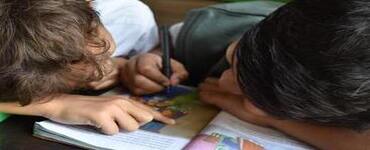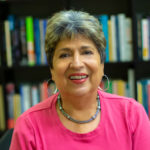The “pause” offered during the coronavirus pandemic permits me to reflect on principles about language, children’s bilingualism, and their education long considered mainstream. I propose that this is a time to unlearn, and relearn anew. I address the invalidity of traditional principles for Latinx bilingual students and propose other understandings.
Key words: Bilingualism, language, language teaching, Latinx, pedagogical practices, translanguaging
I write this as I sit home in isolation after having recovered from the coronavirus. New York City is silent, except for the sounds of sirens carrying patients to hospitals. What can I still say about the education of Latinx minoritized bilinguals when interaction with others is limited and schools are closed? when standardized tests have been suspended and educational authorities have stopped talking about standards, academic language, and categories of children? There is much suffering and much darkness in this time of crisis, but there is also time to unlearn and relearn.
Children in the United States and all over the world are suffering. In New York City, children are questioning their isolation, the absence of parks and playgrounds, of friends and family. A health crisis like the one we are facing hits all children with fear, even if some can escape to summer homes and have the advantages of technology and homeschooling by parents whose jobs can be done from home. What will children know when they come out of this? How will educators continue to care for them, to relieve the fear? What lessons will we have learned? These are all questions that we will have to face.
The question for me now as I write this is: What understandings do I still hold on to when language education, as we knew it, has ceased to exist? How do we navigate the wounds, the heridas that have surfaced in these dark times to reconstruct life anew for all children, and especially for those like Latinx minoritized bilinguals who are most vulnerable?
In what follows, I reflect on some principles about language education and the education of Latinx bilingual children that have been considered mainstream understandings. I propose that we need to unlearn, so that we can relearn anew. I address three categories of mainstream understandings about language and education––1) our understandings about language, 2) our understandings about language proficiency and how these produce categories of learners, 3) our understandings of language teaching.
Here I take up the call made by the Portuguese philosopher Boaventura de Sousa Santos in his work on the “epistemologies of the South” (2007, 2014). Santos calls for a different logic, a way of knowing that includes the knowledge systems of those who have suffered most from the effects of colonialism and global capitalism. I first discuss mainstream understandings, and I propose some alternative thinking of alternatives (Santos, 2007). Thinking from “both sides of the line” allows us to adopt a measure of cognitive justice for these children. The education of these children then is refocused as we relearn what it means to educate with difficult loving care so as to attend to their suffering and fear.
On language and minoritized Latinx bilinguals
I address here two mainstream understandings about the language of Latinx bilinguals:
- They have language deficiencies, especially in English.
- Their language deficiencies extend to Spanish also because what they lack is academic language.
These understandings of language have been constructed in ways that render these bilingual children deficient because they are compared to what is understood as the only valid knowledge—that of monolingual white middle-class children and their communities. When knowledge of language is seen only from the powerful side of the line, with what is said to be “modern science and scholarship,” what is, in reality, the practice of one group is then expected of those whose knowledge has been relegated to the other side of the line, and thus rendered invisible or non-existent.
When these monolingual white middle-class students learn another language in schools, their additive bilingualism, with two languages that reflect different nation-states and cultural systems, is then the only form of bilingualism that is validated. In this way, the dynamic bilingualism that characterizes bilingual communities who live their lives in what Gloria Anzaldúa has called “borderlands” (1987) is maligned. The community’s bilingualism is seen as a “mixture” of languages; their knowledge of language is rendered incomplete, full of errors. When their bilingualism is studied, it is to point out phenomena that does not conform to monolingual use—the use of loans, calques, and what is described as code-switching. In reality, however, the language of bilinguals in communities simply does not fall squarely within the boundaries that have been constructed around named languages like English or Spanish and what is fashioned as “standard language.” The concept of a standard language has been constructed by nation-states and their institutions in an effort to control whose language and knowledge systems are rendered valid. The language of bilingual communities has been made deficient by imposing the knowledge-system of white monolingual middle-class people. In so doing, those on “the other side of the line” have undergone a process of minoritization. Latinx bilingual children’s language is characterized by absences, by what is not there. This renders their translanguaging, that is, their own complex language which does not fit the constructed canons of what states and their institutions propose to be English or Spanish, more and more silent, until it is rendered inaudible and non-existent (for more on translanguaging, see especially García & Li Wei, 2014; Otheguy et al., 2015, 2018).
In the last few years, schools have imposed another language construct that restricts our view of Latinx bilingual students as knowledgeable about language. This construct is what has been called academic language. It is now said that Latinx bilingual students fail not just because they do not “have” English or Spanish, but because they also do not have academic language.
Although scholars have worked assiduously to try to define it (cf. Snow & Uccelli, 2009; Uccelli et al., 2015), we understand less and less what it is. Is it just the language of written academic texts used in the United States? And if this is so, does it include all texts said to be academic, including those in the Humanities and the Social Science? Does it include texts of Latin American philosophers, for example? Is it the language of teachers? Which teachers? Doing what?
System Functional Linguistics (SFL) has been applied to the construct of academic language to identify how grammatical structures are derived from different types of socially relevant tasks within varied social contexts (Schleppegrell, 2012). But even when this work is done by critical sociolinguists who incorporate the language and cultural repertoires of Latinx bilingual students, SFL leaves out the knowledge-system, the forms of consciousness of those considered to be “on the other side of the line.” That is, since Latinx bilingual students are not considered valid members of the only culture and group that has been constructed as legitimate, their knowledge-practice, that is, the ways in which they think about and act on language has been left out. Thus, the concept of academic language adds to the burden and the failure of Latinx bilingual students and renders their knowledge of language and bilingualism as non-academic, popular, intuitive, incomprehensible, or simply wrong.
On language proficiency and student categories
There are two mainstream understandings about language proficiency and how it relates to the categorization of students that circulate as “truths” in educational circles. They are:
- that language proficiency can be measured and evaluated;
- that learners can be categorized according to that proficiency.
The concept of language proficiency is one that responds to the advent of measurement, with modern science restricting the field of knowledge so that it fits within the contours of what can be measured. In order to measure language, it had to be made into an entity made up of grammatical components, an object that human beings either have or do not have more or less.
But language is an activity, a product of complex social action (Becker, 1995; Maturana & Varela, 1984). Language is always a languaging, a verb, always in motion and in relationship to life and its context. As such, language is immeasurable, an ongoing process that defies measurement.
Yet it is the first definition of language as an object that is used in education. Through measurements of what is objectified as language, reflecting the language of white monolingual middle-class people, the “others” are rendered “limited.” And thus, many Latinx bilingual students are labeled as “Limited English Proficient,” or as “English Language Learners.” Note well what I am saying, which is worth repeating. It turns out that Latinx bilingual children are “invented” through these measurements as “limited” and “learners” of a language that actually makes up their bilingualism. The translanguaging of Latinx bilinguals, a more complex and dynamic way of doing language, of languaging with many different interlocutors, is then reduced to a limitation and a deficiency, a lack of proficiency. This in turn makes it possible to create categories of children—those who can be educated, and those who have to first learn “English,” in ways that are simply not theirs.
Latinx bilingual children labeled “English learners” are then seen and listened to through absences, through what they do not have, through what are seen as their limitations. Their emergent bilingualism is negated. Instead of being recognized for what they do with language, with their complex translanguaging, they are penalized for not “having” a language that has been constructed precisely to leave out their own language. The limitation is not that of the children; it is of an educational system that uses invalid measures to rob some of them from rich instruction and enrichment programs in the arts. It is a limitation of an educational system that then reduces instruction for these children on remediating what they are said not to have. Instruction becomes a way to make these bilingual children reach an English language “standard,” that will remain out of reach for them because it requires them to “have” something that has been defined a priori as simply not theirs.
The so-called objective measures of language proficiency have served to amplify categories of limitation, so that more Latinx bilingual children qualify for remedial instruction. Instead of opening up a more generous space where all children can receive an enriching education, more and more Latinx bilingual children fall short of standards that were never meant to include them.
On language teaching
Language educators often adhere to two principles that are accepted as universal:
- That teaching language is linear and follows a natural progression;
- That to teach language, the students’ own language must be banned from the classroom.
Curriculum for language teaching follows a scope and sequence that responds mostly to the language use and development of monolingual middle-class children. But most Latinx bilingual children are simultaneous bilinguals, which means that they are developing their bilingualism at home, usually from the time they are born, as they interact with siblings and family and community members. And yet, the teaching of, for example, English as a second language to Latinx bilinguals labeled “English learners” proceeds as if they have little practice with English, although many have heard it and have used it from the time they learned to talk. For some, now labeled “Long Term English Language Learners” because of faulty notions of language proficiency, English may be the only language they speak.
When teaching Latinx bilingual students who have recently arrived in the United States, the scope and sequence followed in English as a second language programs also treats the language as an object, a series of phonological, morphological, syntactical and lexical elements that can be taught through skill and drill. And although the curriculum of bilingual education programs breaks from this focus on teaching and learning language as an object, the creation and growth of dual language programs where white English-speaking monolingual students participate has meant that a sequence based on a tradition of “foreign language” learning is now given priority. This means that Latinx bilingual children are asked (at least officially, even if it does not happen in reality) to never use “Spanish” during “English” instruction, and never use “English” during “Spanish instruction. This demeans even further the bilingual community’s use of translanguaging. As such, many dual language education programs have become simply a language education program that ignores and punishes with even more fury the bilingualism of the Latinx community.
Educating Latinx bilingual children with difficult loving care
Everything that we have done in the past to “remediate” the language of Latinx bilinguals has failed us. It is time to unlearn these understandings that we have held dear.
But then, what is it that we must relearn? How can we then teach Latinx bilingual children with loving care that is not simply an emotion, but an action? The answer has to do with teaching Latinx bilingual children lovingly about the difficult histories that have surrounded language. The answer has to do with incorporating the knowledge-practice from both sides of the line, not just from the powerful side of the line.
Educators of Latinx bilingual students must pose two questions of their teaching:
- How can I teach the English language as a site of conflict and a result of colonialism and global capitalism, rather than the solution?
- How can I teach the difficult history of Spanish language imperialism and the effects it has had in Latin America, as well as in those who have crossed the line into the imperial North?
Instead of teaching with a goal of helping Latinx bilingual children meet externally-imposed criteria, educators must ask themselves:
- What have been the consequences of thinking that educating Latinx bilingual students is solely about meeting language standards, having academic language, and doing well in language proficiency tests?
- What have been the consequences of not caring for them enough to face the difficult task of showing them how language has been used to gain privilege and success for some and exclude others?
Living with the coronavirus crisis might help give educators the courage to act differently when they return to classrooms. To heal we will need to understand the difficult histories of how the crisis evolved. This might give us the courage we need to help children understand the role that language in schools has played in the systemic and unjust suffering of Latinx bilingual children. As language educators, we must relearn, as we reflect during this time of coronavirus. Only by shifting gears will we ensure that Latinx bilingual children resignify their lives and education with dignity.
References
Anzaldúa, G. (1987). Borderlands/La frontera: The new mestiza. Aunt Lute Books.
Becker, A. L. (1995). Beyond translation: Essays toward a modern philosophy. University of Michigan Press.
García, O., & Li Wei. (2014). Translanguaging: Language, bilingualism and education. Palgrave Macmillan Pivot.
Maturana, H., & Varela, F. (1984). El árbol del conocimiento: Las bases biológicas del entendimiento humano. Lumen/Editorial Universitaria.
Otheguy, R., García, O. & Reid, W. (2015). Clarifying translanguaging and deconstructing named languages: A perspective from linguistics. Applied Linguistics Review, 6(3), 281-307. https://doi.org/10.1515/applirev-2015-0014
Otheguy, R., García, O., & Reid, W. (2018). A translanguaging view of the linguistic system of bilinguals. Applied Linguistics Review, 10(4), 625-651. https://doi.org/10.1515/applirev-2018-0020
Santos, B. de S. (2007). Beyond abyssal thinking: From global lines to ecologies of knowledges. Review (Fernand Braudel Center), 30(1), 45-89. https://www.jstor.org/stable/40241677
Santos, B. de S. (2014). Epistemologies of the South: Justice against epistemicide. Routledge.
Schleppegrell, M. J. (2012). Systemic functional linguistics: Exploring meaning in language. In J. P. Gee & M. Handford (Eds.), The Routledge handbook of discourse analysis (pp. 21-34). Routledge.
Snow, C. E., & Uccelli, P. (2009). The challenge of academic language. In D. R. Olson, & N. Torrance (Eds.), The Cambridge handbook of literacy (pp. 112-133). Cambridge University Press.
Uccelli, P., Barr, C., Dobbs, C., Galloway, E. P., Meneses, A., & Sanchez, E. (2015). Core academic language skills (CALS): An expanded operational construct and a novel instrument to chart school-relevant language proficiency in preadolescent and adolescent learners. Applied Psycholinguistics, 36(5), 1077-1109. https://doi.org/10.1017/S014271641400006X






